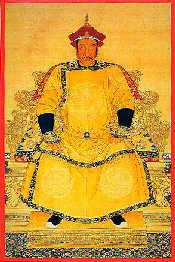 Nurhachi, the Manchu ruler, was the founder of the Later Jin Dynasty (1616-1636) and laid the foundation of the Qing Dynasty (1644-1911). After his death, Nurhachi was given the title of Qing Taizu when the dynasty was founded, meaning the first emperor of the Qing Dynasty.
Nurhachi, the Manchu ruler, was the founder of the Later Jin Dynasty (1616-1636) and laid the foundation of the Qing Dynasty (1644-1911). After his death, Nurhachi was given the title of Qing Taizu when the dynasty was founded, meaning the first emperor of the Qing Dynasty.
He was born in a Manchu slave-owner family in today's Xinbin County in Liaoning Province in 1559 and died from diseases at the age of 68 in 1626. His father and grandfather were nobles of a Nuzhen tribe in northern China and served as frontier officials for the Ming Dynasty (1368-1644). Due to his noble birth, Nurhachi from little age had excelled in martial art.
The ancestry of the Manchus can be traced back to Nuzhen tribe more than 2000 years ago, which was native to the Changbai Mountains and the drainage area of the Heilongjiang River in Northeast China. By the Ming Dynasty, the Nuzhen people were still chained by slavery and divided into several warring tribes, resulting in backward social production.
When he was 10 years old, Nurhachi began to live with his grandfather due to the death of his mother. Since then, he constantly traveled to Fu Shun in today's Shangdong Province to trade with the local people, who he soon made friends with. Gradually, he learned the Han language and developed a love for the Han culture.
In 1595 when he was 19 years old, the Ming court conferred on Nurhachi the title of "Dragon-Tiger General", after making him a garrison commander in 1582 and public procurator of Heilongjiang Province in 1589. Frequent trips to Beijing brought him full awareness of developments in the Han areas, which in turn exerted great influence on him.
Towards the end of the Ming Dynasty, Nurhachi organized his troops under the Banner System. In 1616, Nurhachi proclaimed himself "Sagacious Khan" and established a slave state Jin, known as the Late Jin Dynasty in history. In August 1617, after 30 years' effort, he finally united all the Nuzhen tribes and laid the foundation for the establishment of the Qing Dynasty.
Once the Nuzhens were united, Nurhachi initiated the Eight Banner System, under which all people were organized along military lines and would go into battle as militia in time of war. Under the strong influence of the Han people, the Manchu slave system soon underwent a speedy development towards feudalism.
During the war against the Ming Dynasty (1368-1644), his troops took over the Liaohe River valley after their victory in the Saerhu War. Nurhachi moved his capital to Liaoyang in 1621, and then to Shenyang in 1625. In 1626 he was defeated by the Ming army and died of battle wounds on September 30 in the same year. After his death, Nurhachi was buried in the Fu Mausoleum in Shen Yang.
In 1635, Huang Taiji, the eighth son of Nurhachi, chose the name of Manchu to replace Nuzhen for his people. In the following year, when he ascended the throne, he adopted Great Qing as the name of his dynasty. In 1644, the Qing troops marched south of Shanhaiguan or Shanhai Pass and unified the whole of China, initiating nearly 300 years of Manchu rule throughout the country.
